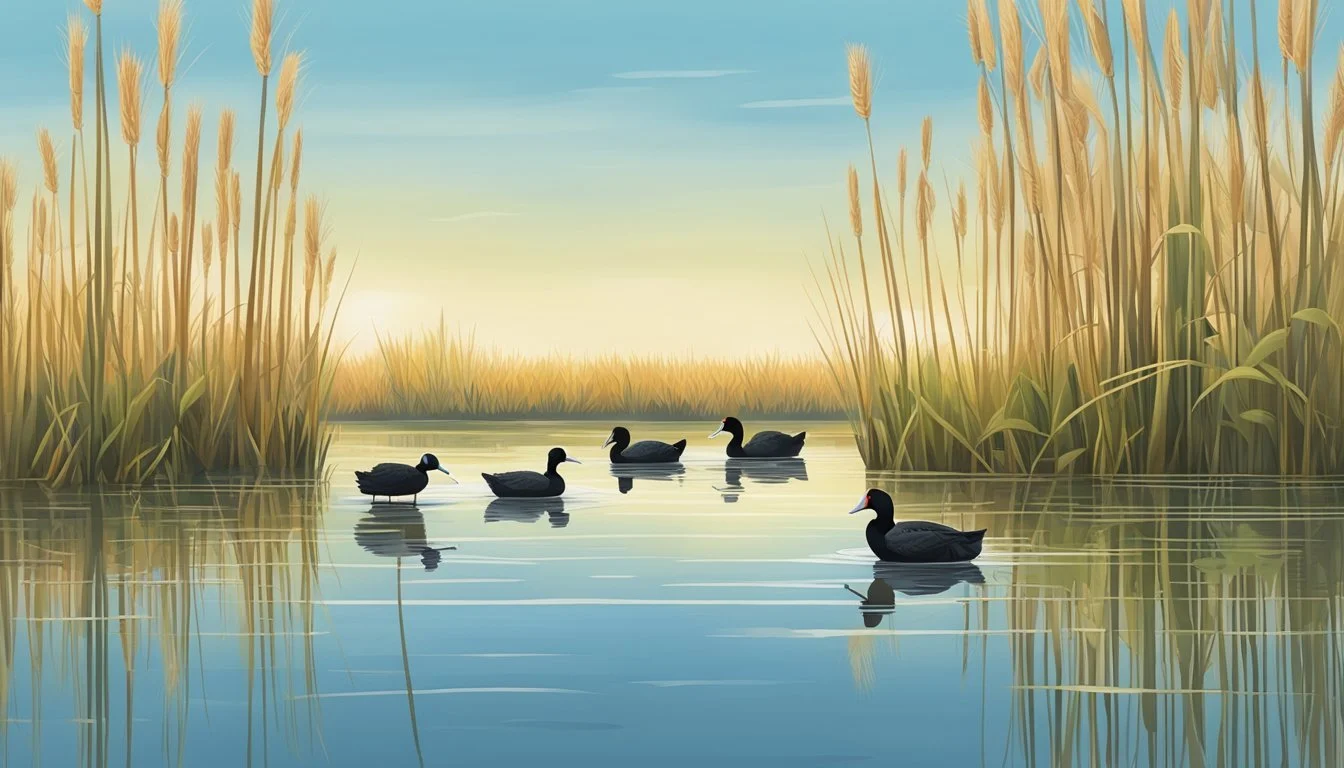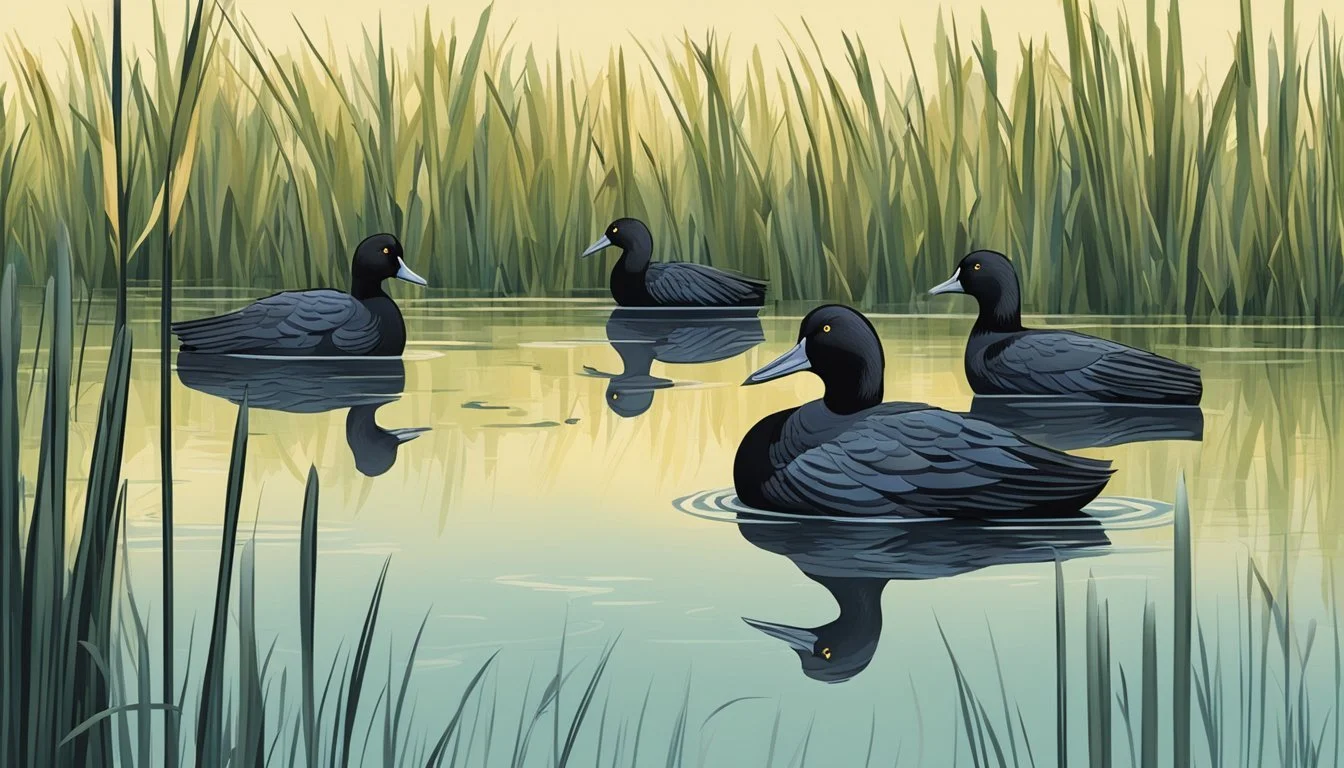Coots Hunting Seasons
Regulations and Timeframes for Hunters
This Article is Part of Our Guide on Hunting Seasons for Over 70 Common Game Species
Coots, often mistaken for ducks (What wine goes well with duck?) due to their presence in similar habitats, are a common target for hunting enthusiasts. These birds, distinguishable by their chicken-like beaks and lobed feet, provide a different challenge and experience compared to traditional duck hunting. Coots, described by their scientific name Fulica americana, can be found in a variety of wetland environments across North America. Unlike ducks, which can propel themselves into flight directly from the water's surface, coots typically require a running start to take off, which adds a unique aspect to hunting them.
Recognizing the popularity of coot hunting, wildlife management agencies have established specific hunting seasons to regulate and control the harvest of these birds. Hunters interested in pursuing coots must adhere to these set season dates, bag limits, and other regulations to ensure sustainable populations. For instance, in states like North Dakota, hunting seasons for coots are often aligned with duck hunting seasons, providing ample opportunities for hunters during the fall migration periods.
In addition to general hunting regulations, there are specific requirements concerning the type of ammunition used. The nationwide ban on lead shot for hunting waterfowl, which includes coots, has been in effect since 1991. Hunters are required to use nontoxic shot to prevent lead poisoning in both the birds and the environment. As a result, hunters must stay informed about the regulations and guidelines that govern the hunting of coots to ensure both a successful and legal hunt.
Overview of Coots Hunting
Hunting coots provides an alternative waterfowl experience, distinct in several ways from typical duck hunting. Hunters not only appreciate coots for their ease of identification but also for the unique regulations and opportunities they present as migratory birds.
Coots Identification
The American Coot (Fulica americana) is easily recognizable and often mistaken at a glance for ducks. Yet, on closer inspection, they have significant differences. Adult coots sport a slate-gray body, making them appear black from a distance, with a distinct white bill and a sloping forehead. Unlike ducks, they possess chicken-like beaks and lobed feet, as opposed to the webbed feet of ducks. Both male and female coots are similar in size, with an average length of 16.2 inches and weights of 1.5 lbs for males and 1.2 lbs for females.
Comparative Waterfowl Species
Coots are part of the rail family and are considered migratory game birds. When comparing to other waterfowl like ducks, coots tend to form large flocks and prefer fresh water lakes and reservoirs. They migrate mostly at night and may go unnoticed due to their less desirable reputation amongst hunters. Unlike many duck species that are often the highlight of waterfowl hunting seasons, coots are not as extensively hunted, even though they are plentiful across various states. This can result in states setting generous bag limits, which sometimes reach up to 25 birds per hunter.
Legal and Ethical Considerations
When hunting coots, adhering to set regulations and ethical standards is vital. Hunters are required to understand and follow the laws, obtain the necessary licenses, and engage in practices that support wildlife conservation.
Regulatory Bodies
The U.S. Fish and Wildlife Service (USFWS) and state wildlife agencies are the primary regulatory bodies that establish hunting regulations for migratory birds like coots. These authorities determine open seasons, bag limits, and other hunting guidelines that hunters must follow. Regulations are often statewide but can vary, requiring hunters to stay informed about the specific rules in their hunting area.
Hunting Licenses & Permits
Individuals need a valid hunting license and appropriate permits to hunt coots legally. The licensing process ensures that hunters have the basic knowledge of the rules and safety practices while contributing financially to conservation efforts. For migratory birds, hunters typically need a state license as well as a Migratory Bird Hunting and Conservation Stamp, commonly known as a Duck Stamp.
List of Required Documentation:
State Hunting License
Federal Duck Stamp
State Migratory Bird Permit (if required by the state)
Wildlife Conservation
Hunting regulations are designed not only for safety and legality but also to support wildlife conservation. By following established guidelines, hunters help maintain healthy coot populations and ensure the sustainable use of wildlife resources. Ethical hunting practices, such as fair chase and respect for wildlife, are integral to conservation efforts and maintaining the sport's integrity.
Fair Chase: Ethical hunters do not take unfair advantage of coots and give them a fair chance to escape.
Respect for Wildlife: Ethical hunters value coot lives and prioritize humane hunting methods.
Hunting Seasons and Zones
In the meticulous management of hunting seasons and specific zoning, regulatory bodies across various regions set clear guidelines to ensure sustainable and legal hunting practices, particularly for the coots during their respective seasonal timelines and within designated zones.
Coots Seasonal Timelines
Missouri:
Middle Zone: November 18, 2023 - January 7, 2024
Maryland does not allow coots hunting on Sundays, aligning with the broader restriction on migratory bird hunting.
Louisiana defines its seasons based on eastern and western divisions:
East Zone: November 18 - December 3 and December 16 - January 28
West Zone: Specific dates vary, closely aligning with the East Zone’s temporal distribution to facilitate a standardized approach to waterfowl season.
Zoning for Hunting
Zoning regulations are crucial for hunters to understand where and when they can legally pursue their game.
Missouri provides a zone boundary map, dividing the state into areas with distinct season dates.
In Maryland, hunting is restricted due to the absence of Sunday game days, and regulations make it compulsory to possess appropriate licenses and permits.
Louisiana prescribes hunting boundaries through:
East Zone: Geographically defined to encompass specific parishes, abiding by the state's management plan.
West Zone: Created with a clear demarcation from the East Zone, offering separate dates for regular and extended falconry seasons.
Each state's wildlife conservation department typically provides detailed maps and resources to guide hunters through the zoning nuances.
Equipment and Techniques
The successful hunter knows that the right equipment and technique are paramount. Choosing appropriate firearms and ammunition, utilizing decoys and calls effectively, and employing strategic hunting methods are crucial steps to ensure a productive coot hunting experience.
Firearms and Ammunition
When hunting coots, hunters typically use a 12-gauge shotgun for its versatility and suitability for waterfowl. It is important to select a shotgun with a comfortable fit and reliable action, be it semi-automatic, pump, or over-and-under. Hunters should use steel shot sizes ranging from #2 to #6, as lead shots are banned in waterfowl hunting due to environmental regulations.
Decoys and Calls
Decoys play a vital role in simulating a natural and inviting habitat for coots. A typical spread may contain various floating decoys to mimic a feeding group. Here's how to set up your decoys:
Resting Decoys: Place in calm water to represent resting birds.
Feeder Decoys: Position these in shallower water to imitate foraging coots.
On the other hand, electronic calls or mouth-operated calls can be effective to attract coots by replicating their distinct calls. Timing and volume are critical—overuse can deter coots rather than attract them.
Hunting Strategies
The most effective hunting strategy is to identify the habitat where coots are likely to feed and rest. Coots prefer freshwater marshes and ponds, and they can be spotted in both open water and amongst vegetation.
For stealthy approaches, hunters may opt for:
Jump Shooting: Quietly walking along the shorelines or using a shallow-draft boat to reach the birds.
Stalking: Moving cautiously to get within shotgun range without alerting the coots.
Setting up before dawn in well-scouted locations increases the chance of success as coots are most active during the early hours.
Bag Limits and Hunting Regulations
In regulating the hunting of coots, authorities set specific bag limits and enforce strict hunting regulations to ensure sustainable wildlife populations and fair chase practices.
Daily and Possession Limits
Daily Bag Limit:
The maximum number of coots a hunter may harvest in a day is typically restricted. For example, during the 2023-2024 season, a hunter may be allowed to take a specified number of coots per day.
Possession Limit:
A possession limit commonly refers to the total number of coots a hunter can possess at any given time. This limit is generally set at a multiple of the daily bag limit and includes coots stored at home, in transit, or in the field.
Species-Specific Restrictions
Certain regulations can restrict the number of specific breeds or species of waterfowl within the aggregate bag. Hunters must comply with these species-specific bag limits to avoid penalties and ensure they are participating in the conservation efforts mandated by the wildlife management authorities.
Shooting Hours
Hunting is typically allowed from one-half hour before sunrise to sunset for coots. Hunters should verify the exact shooting hours as they can vary by jurisdiction and are subject to change based on the hunting season or special hunting days established for youth, veterans, or active military personnel.
Youth, Veteran, and Special Hunts
Special hunting seasons are designated to encourage youth and honor veterans' contributions. These seasons provide young hunters and veterans with unique opportunities for waterfowl hunting, allowing them to participate outside the regular hunting dates.
Youth Hunting Programs
Youth Hunting Programs are designed to introduce those under the age of 18 to the traditions of hunting. These programs often coincide with special hunting days that fall outside of the typical waterfowl season, affording young hunters the chance to learn and experience hunting in a less crowded environment. For instance, Maryland has specified special hunt days for youth hunters, ensuring they have the opportunity to engage in waterfowl hunting under supervision and with an emphasis on safety and ethics.
Veteran Appreciation Hunts
In appreciation for their service, veteran appreciation hunts are set aside exclusively for those who have served in the armed forces. To participate, veterans and active military personnel must provide identification, such as a DD214 or Active Duty I.D. card, during the hunt. These hunts often occur on specially designated days and aim to provide veterans with a rewarding outdoor experience, allowing them to practice skills such as teamwork and patience, while also enjoying the camaraderie of fellow hunters.
Additional Species
In the realm of hunting, while coots provide unique opportunities, various other species also contribute to a diverse hunting season. The regulations for each species are informed by their ecological status and migratory patterns and are set by balancing conservation needs with hunting tradition.
Other Waterfowl and Game Birds
Ducks: Hunters seeking waterfowl beyond coots often target duck species including mallards, wood ducks, pintails, black ducks, scaup, readheads, and canvasbacks. Duck hunting seasons generally run concurrently with coot seasons, though bag limits for ducks differ and specific species such as teal and canvasbacks may have their own separate regulations or conservation measures.
Geese: White-fronted geese, snow geese, and Canada geese (including Ross's geese) are also popular among hunters. Their seasons are set according to migratory patterns, with some areas allowing hunting during the spring conservation season.
Other Birds: Migratory game birds like doves, snipe, and woodcock are part of managed hunting seasons. Mourning doves and white-winged doves, in particular, are sought after during their respective seasons, which vary by state. The sora and Virginia rails present additional opportunities, as do sea ducks for coastal hunters, including species like scoters and harlequin ducks.
Non-waterfowl Hunting Opportunities
Small Game: Hunters interested in small game have a variety of species to consider, such as squirrels, rabbits, and quail (What wine goes well with quail?). Hunting seasons usually span several months, allowing ample time to participate.
Turkey: Wild turkey seasons are separate with both fall and spring hunts, depending on the state guidelines. These are highly regulated to ensure population health.
Deer: White-tailed deer represent a key big game species, with dedicated seasons including bow, muzzleloader, and firearm segments across states.
Other Big Game and Furbearers: Other huntable big game may include black bear and elk in certain regions. Furbearer hunting, targeting species like bobcats and coyotes, usually falls within the small game category but often extends into periods outside of typical small game seasons.
Additional Hunting: Virginia rails and sora may be hunted during specific seasons. Similarly, seasons for furbearers such as bobcats, raccoons, and coyotes are set by state wildlife agencies. Crows are unique in that they are not considered game birds in many areas, but are still huntable during specific seasons.
With each species, hunters must adhere to the regulatory frameworks that govern season timings, bag limits, and permissible methods of take. These measures are critical to ensuring sustainable game populations and a continued hunting heritage.
Conservation and Research
Conservation and research initiatives are critical to ensuring sustainable coot populations and their habitats. They provide essential data for setting appropriate hunting seasons and harvest limits.
Habitat Restoration Efforts
Conservations prioritize habitat restoration as a core strategy in maintaining healthy environments for migratory game birds, including coots. Efforts include:
Wetland Restoration: Reestablishment and protection of wetland ecosystems crucial for coot foraging and breeding.
Pollution Control: Reduction in water pollution levels to provide safer habitats for coots and other wildlife.
Coots Population Studies
Population studies of coots yield vital harvest information that guides hunting regulations. These studies involve:
Count Surveys: Conducting annual counts to monitor resident and migratory coot populations.
Breeding Success Rates: Assessing breeding data to ensure sustainable population levels are maintained.
By integrating these conservation and research efforts, stakeholders can help balance ecological needs with recreational hunting interests.
Legal Restrictions
Regulations for hunting coots are established to balance population management with conservation efforts. These encompass permissible methods, seasonal constraints, and ensure adherence to designated limits.
Hunting Method Limits
Coot hunting must comply with federal and state restrictions, which rigorously regulate the methods by which waterfowl can be hunted. Falconry, for instance, is a permitted hunting method, but the falconry seasons often have separate timelines and regulations compared to the general waterfowl hunting seasons.
Trapping or the use of night vision or electronic equipment to hunt coots is strictly prohibited. The use of non-toxic shot is mandatory; toxic alternatives like lead shot have been banned nationwide since 1991. Specific zones have their own daily limits, so hunters should reference the corresponding state legislation like the Pennsylvania Game Commission for local restrictions.
Zone Falconry Daily Limit Notes Atlantic Allowed Varies Check local regulations Mississippi Allowed Varies Refer to season dates Central Allowed Varies Falconry seasons differ Pacific Allowed Varies Nonresident requirements apply
Migratory bird hunting, including coots, often defines separate limits for species such as blue and Canada geese, mergansers, sora, and brant.
Prohibitions and Penalties
Penalties for violating coot-hunting laws can be severe, with fines and potential revocation of hunting privileges. It is illegal to hunt waterfowl, including coots, using bait. Bait is defined as placing or distributing food that can attract waterfowl to the area where hunting takes place. Authorities like the Pennsylvania Game Commission may impose stringent repercussions for nonresidents and residents alike who do not follow the 2023-2024 regulations.
During the 2023-2024 seasons, staff and media are also required to adhere to existing hunting restrictions, as breaking these laws compromises not only the hunter but also the integrity and reputation of these professions within the conservation community.






